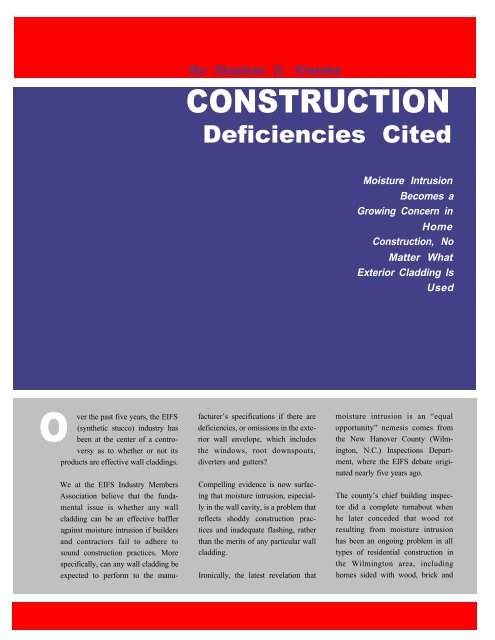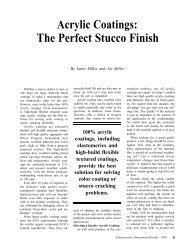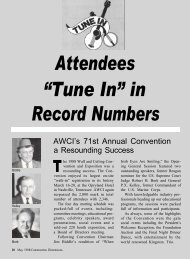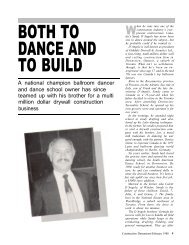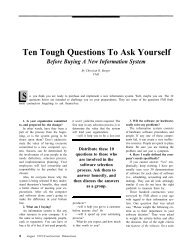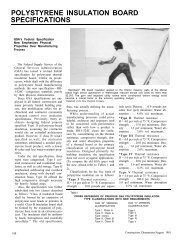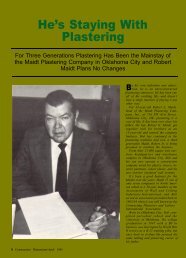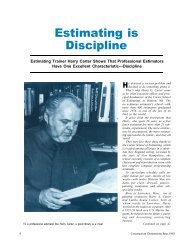By Stephan E. Klamke - AWCI
By Stephan E. Klamke - AWCI
By Stephan E. Klamke - AWCI
Create successful ePaper yourself
Turn your PDF publications into a flip-book with our unique Google optimized e-Paper software.
�<br />
ver the past five years, the EIFS<br />
(synthetic stucco) industry has<br />
been at the center of a controversy<br />
as to whether or not its<br />
products are effective wall claddings.<br />
We at the EIFS Industry Members<br />
Association believe that the fundamental<br />
issue is whether any wall<br />
cladding can be an effective baffler<br />
against moisture intrusion if builders<br />
and contractors fail to adhere to<br />
sound construction practices. More<br />
specifically, can any wall cladding be<br />
expected to perform to the manu-<br />
<strong>By</strong> <strong>Stephan</strong> E. <strong>Klamke</strong><br />
������������<br />
������������������<br />
facturer’s specifications if there are<br />
deficiencies, or omissions in the exterior<br />
wall envelope, which includes<br />
the windows, root downspouts,<br />
diverters and gutters?<br />
Compelling evidence is now surfacing<br />
that moisture intrusion, especially<br />
in the wall cavity, is a problem that<br />
reflects shoddy construction practices<br />
and inadequate flashing, rather<br />
than the merits of any particular wall<br />
cladding.<br />
Ironically, the latest revelation that<br />
Moisture Intrusion<br />
Becomes a<br />
Growing Concern in<br />
Home<br />
Construction, No<br />
Matter What<br />
Exterior Cladding Is<br />
Used<br />
moisture intrusion is an “equal<br />
opportunity” nemesis comes from<br />
the New Hanover County (Wilmington,<br />
N.C.) Inspections Department,<br />
where the EIFS debate originated<br />
nearly five years ago.<br />
The county’s chief building inspector<br />
did a complete turnabout when<br />
he later conceded that wood rot<br />
resulting from moisture intrusion<br />
has been an ongoing problem in all<br />
types of residential construction in<br />
the Wilmington area, including<br />
homes sided with wood, brick and
�������������������������<br />
�����������������������<br />
��������������������������<br />
vinyl. That assessment was substantiated by a local contractor,<br />
who told Greater Wilmington Business that there is evidence<br />
of moisture intrusion in 95 percent of new construction in the<br />
Wilmington area.<br />
ing that only EIFS-clad houses<br />
were susceptible to serious moisture<br />
damage, the Inspections<br />
Department created a cauldron of<br />
doubt and fear that has done<br />
untold harm to the EIFS industry<br />
and to thousands of owners of<br />
EIFS homes that have lost their market value.<br />
structed homes.<br />
The chief building inspector further suggested that state-mandated<br />
vapor barriers have exacerbated the problem and should ������������������<br />
be banned in wet, coastal areas. He also, for the first time, cit-<br />
ed windows as “culprits” in the moisture-intrusion debate. In<br />
the meantime, no homes have been built with EIFS in the<br />
Wilmington area for nearly five years. Yet, by previously insist-<br />
The overriding message in the chief building inspector’s advisory<br />
is that moisture intrusion is a fact of life in poorly con-<br />
And there appears to be an ample inventory of poorly constructed<br />
homes in this country. Barry Eliason, owner of a St.<br />
Paul, Minn., stucco company that tests for water problems in<br />
conventional stucco, says he hasn’t seen a “single home that is<br />
less than 20 years old that doesn’t have a significant area of moisture<br />
intrusion.” In many cases, the damage is not covered by the<br />
homeowners’ insurance policies and can surface after the warranties<br />
have expired, leaving the homeowner to pick up the tab,<br />
or sell the house to an unsuspecting buyer.<br />
While nobody has specifics on the severity of the moisture<br />
intrusion problem, it’s significant enough that the federal government<br />
has launched studies to explore water problems in new<br />
homes, according to a June article in the Minneapolis Star Tribune.<br />
According to the article, “The Forest Products Laboratory<br />
in the U.S. Department of Agriculture has been studying<br />
water problems in houses for two years, but it may be two more<br />
years before conclusions are reached.”<br />
Ever since the energy crisis in the 1970s homebuilders have<br />
been constructing tighter houses in efforts to reduce energy<br />
costs and make homes more comfortable. At the same time,<br />
new engineered-wood products have replaced traditional wood<br />
boards for sheathing and even I-beams in residential construction.<br />
Along the way, rainwater has become a dangerous villain,<br />
suggests the Star-Tribune article.<br />
��������������<br />
To be sure, rain has always been a problem for houses. But<br />
unlike walls in older homes, newer walls are more prone to hold
moisture. That makes the task of keeping<br />
water out more important than ever.<br />
Yet, some proven techniques for keeping<br />
moisture out of walls are no longer used,<br />
or are used improperly<br />
For any cladding to be effective, moisture<br />
entry points must be adequately<br />
flashed and sealed, and other watershed<br />
components must be properly installed<br />
and maintained.<br />
Bill Rose, a research architect at the<br />
Building Research Council at the University<br />
of Illinois, says that at least some<br />
of today’s moisture intrusion problems<br />
can be attributed to the increased reliance<br />
on unskilled labor at construction<br />
sites. Many of these jobs were once held<br />
by seasoned professionals who knew<br />
how to keep water out of a building, he<br />
says. Today, the situation is different.<br />
Indeed, homes are complex entities consisting<br />
of thousands of components that<br />
must be carefully integrated. Moreover,<br />
the performance of any home can be<br />
drastically affected by factors such as<br />
wind, rain, snow and soil moisture. In<br />
addition, every home must be properly<br />
maintained to remain in peak condition.<br />
Those that are not will be more<br />
susceptible to experience moisture damage,<br />
especially if they were built or<br />
remodeled since the mid-1970s.<br />
In recent years, much has been written<br />
and said about the need to protect wood<br />
sheathing from moisture in residential<br />
construction through the use of house<br />
wraps or building paper. The wide range<br />
of products available for use as weather<br />
���������������������������<br />
������������������������������<br />
bafflers, many with different performance<br />
characteristics, has created a great<br />
deal of confusion. Building paper—<br />
even 15-pound felt—can negatively<br />
impact a wall’s drying capability if a significant<br />
amount of water seeps into the<br />
wall cavity.<br />
The best way to avoid moisture problems<br />
in walls, regardless of the cladding<br />
or the local climate, is to employ only<br />
code-compliant application practices<br />
and high-quality, properly installed wall<br />
components, including effective flashing<br />
and sealants around critical moisture<br />
entry points. All wall claddings are<br />
designed to resist moisture. It’s how<br />
they’re installed and maintained that<br />
makes the difference.<br />
About the Author<br />
<strong>Stephan</strong> E. <strong>Klamke</strong> is executive director<br />
of the EIFS Industry Members Association,<br />
a Georgia-based trade association<br />
that represents manufacturers, distributors,<br />
contractors, suppliers and others<br />
associated with the EIFS industry


